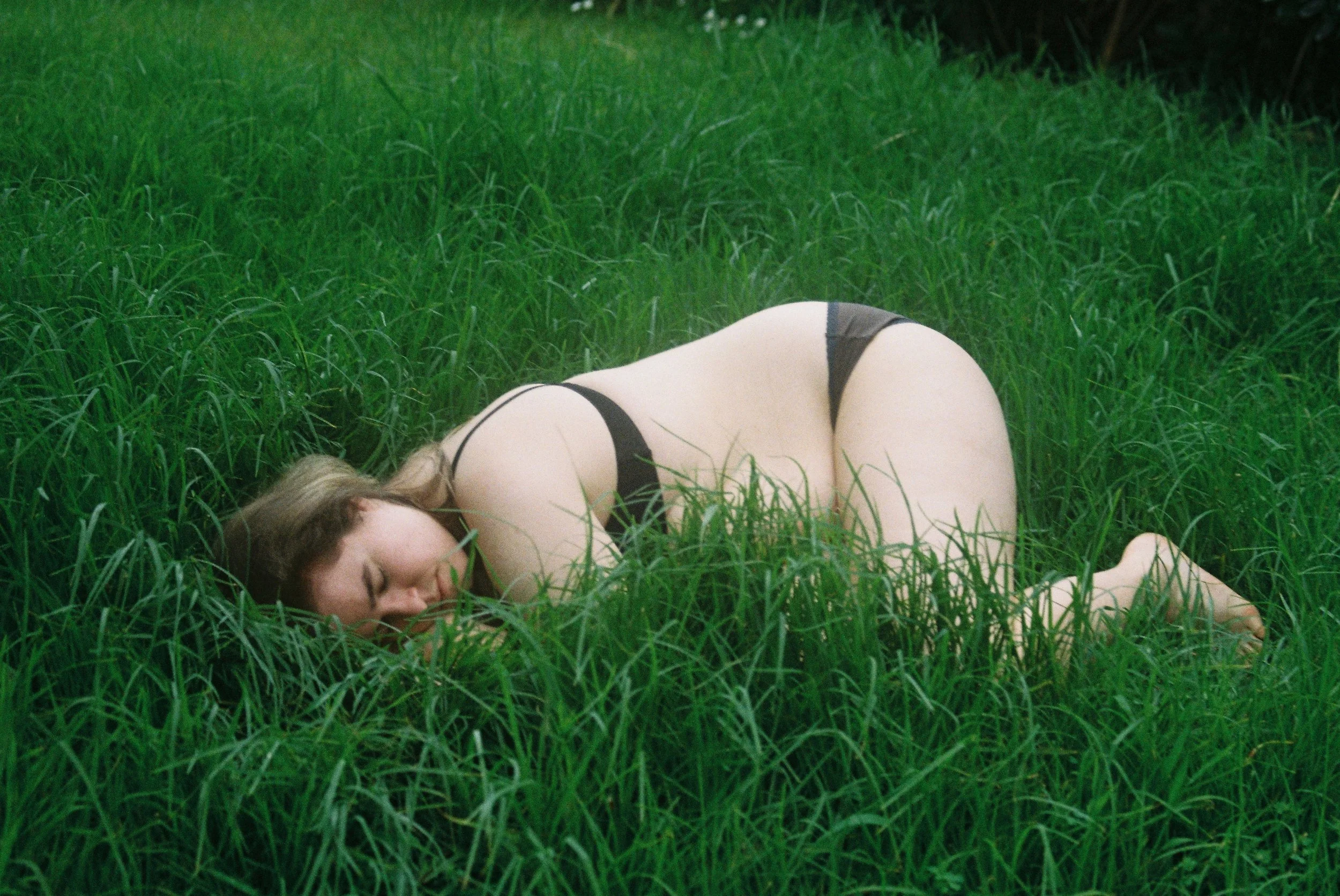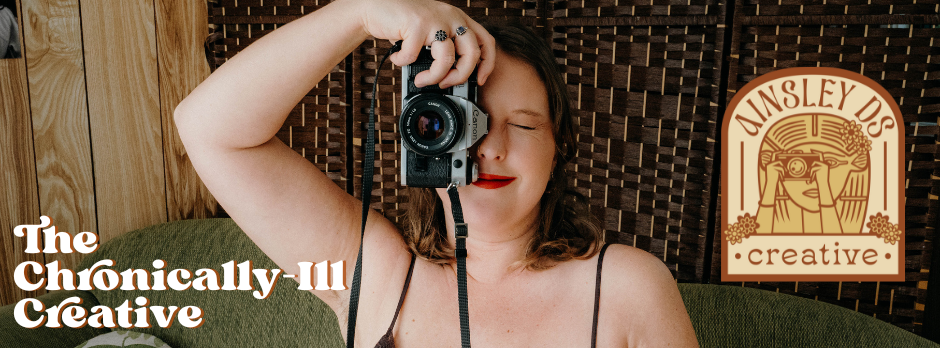How Do You Love Your Body When You Have a Chronic Illness?
And do you even have to?
How to live with softness, kindness and gentleness towards your body.
Loving your body is hard enough in a world obsessed with perfection. But chronic illness adds an entire extra layer-exhaustion, pain, medical trauma, body changes, unpredictability, and the simple reality of being in survival mode.
When you’re just trying to make it through the day, the last thing you have the bandwidth for is worrying about how you look. Your appearance, your style/ fashion, makeup, basic grooming…even thinking about those things can feel laughably out of reach.
Survival mode demands everything. It strips things down to the essentials.
But then what happens when you slowly begin to shift outside of that mode and start noticing your body again?
When your body and brain finally start to leave survival mode - even just a little- you might look in the mirror and barely recognise yourself.
Your body may have changed.
Your self-care routines may have vanished.
Your sense of identity might feel blurry.
That’s what happened to me….And it was confronting. It’s taken me a while to start to feel like myself again, and I am still learning to love, accept and work with this new body.
So how do you rebuild a relationship with your body after illness has shaped it so dramatically?
How do you show it kindness when it still hurts you?
And really — do you even have to love your body at all?
Let’s untangle this gently.
Learning to love and accept your body after big changes and health issues can be a journey.
You Don’t Need to Love Your Body to Treat It Kindly
The self-love industry sometimes makes it sound like the only acceptable goal is to adore every inch of your body. But when your body feels like it’s failing you, that expectation can feel like pressure layered on top of pain. And we definitely don’t need that.
Here’s the truth:
You do NOT need to LOVE your body to respect it and show kindness towards it.
You don’t need to try to romanticise chronic illness as a journey to self acceptance or overcoming pain.
You don’t need to be grateful for symptoms that steal time, energy, or possibilities because it’s “teaching you” something.
What you can aim for is something much more humane and simple:
Body neutrality- looking at your body from a neutral lens (neither good nor bad).
Body acceptance- accepting your body for what it is instead of trying to constantly “improve” or reach new “goals” ( see more below).
Small acts of kindness- treating your body like you would treat a loved one.
Reconnect With Your Body- Slowly and gently- Reconnecting doesn’t mean forcing confidence, acceptance or positivity. It can be subtle, slow, even awkward at first.
These meet you where you actually are, not where inspirational quotes think you should be.
Your body deserves kindness, just like any one else’s does.
Practice Body Acceptance (Not Perfection)
Body acceptance acknowledges the reality of your body today, even if it’s different from the body you once knew.
Acceptance is not giving up. It’s not pretending you don’t wish things were easier, or different.
It’s not denying your grief.
It’s saying:
“This is my body right now, and I will treat it with the kindness it deserves.”
Get Used To Seeing Yourself Again
Spend time looking at your body, not to judge, just to witness, observe and note.
Look in the mirror nude.
In comfy clothing.
In something you feel nice in.
With makeup.
Without makeup.
Say out loud what you see, what has changed, what surprises you. But make sure you are doing it with neutrality. Simply label what is there, and let it go.
This helps you rebuild familiarity with a body that may feel foreign after years of symptoms, medications, surgeries, stress or entire body changes.
See Your Body Through The Eyes of Someone Who Loves You
Think of someone who genuinely adores you, a partner, friend, sibling, parent, or even a pet.
Does your extra tummy roll make them love you less?
Does your ‘bad’ skin change how they value you?
Does your bloating, scarring, or fatigue make you less worthy in their eyes?
Absolutely not.
Borrow their lens until you can soften your own.
Expose Yourself to Diversity
If you only ever consume media showing one type of body, of course you’ll feel alienated from your own.
Seek out difference intentionally:
Follow diverse, chronically ill, and plus-size creators. Some of my personal favourites are… Sonya Renee Taylor, Danae Mercer, Megan Jayne Crabbe, Mike Zazon, Your Daily Dose of Self Love and from NZ - Katma.
Consume media showcasing disabled, chronically ill, or unconventional bodies.
Look at art featuring fuller bodies, older bodies, trans bodies, scarred bodies.There is so much of it hidden away in museums and galleries.
Visit a nudist centre, undie party, or even simply a busy beach if it feels safe and interesting. Quietly observe (without being creepy) and take note of all the different kinds of bodies that exist. You’ll discover how many shapes, textures, and variations bodies naturally come in.
I bet you're not judging anyone for having cellulite, wrinkles or hairy legs, so why would you judge yourself for this? These exercises expand your definition of “normal” to bodies that exist outside mainstream media. The more diverse bodies you see, the more normal your own becomes to you.
Touch and Tune-In Without Pressure
Gentle forms of connection like self-massage, stretching, or placing a hand on your chest or belly can help you feel embodied in tiny, manageable moments. Hold your body, think of something positive (or even neutral) about it, and say it to yourself. For example, stretch your legs and say “thank you legs for always getting me where I need to go”, or place your hands on your tummy and say “thank you tummy for not hurting today”. Those little moments of gratitude and reconnection can make a big difference in the way we perceive our body and its functions (or lack of).
Listen to Your Body — It’s Trying to Talk to You
It took me so long to realise this, but so much of chronic illness is about learning what your body is trying to communicate. Listening doesn’t mean giving in; it means tuning in and figuring out why your body is doing the things that it is doing. Sometimes the answer is clear, we might already know it, and sometimes it remains elusive. But there are ways to dig deeper.
Ask:
What could my body be trying to tell me right now?
What helps me feel less pain?
What foods feel good today?
How much rest do I need today?
What does rest actually mean for me?
Which movements feel supportive instead of punishing?
Your body will not always speak kindly, especially in flare states, but it will always tell the truth.
The more you listen, the more safety you rebuild within yourself. And the more connected you can feel to your body, your appearance and your sense of self.
Dress for the Body You Have Today, Not the One You Miss!
A wildly underrated form of body acceptance?
GO SHOPPING! And buy clothes that actually fit and feel good.
While I am pretty staunchly anti-capatalist and anti-fast fashion, there is zero point in not buying new clothes if it means you’re never leaving the house. Op-shops can be a little stingy on the plus size selection, but websites like designer wardrobe usually have a great selection of 14+ items available.
I’ve learned this from experience- Stop torturing yourself with jeans a size too small that dig into your stomach and trigger symptoms.
Stop saving outfits you love for a mythical “better day.”
Stop squeezing, shaping, lifting, tucking, hiding.
Buying clothes that fit your current body can genuinely change how you perceive yourself.
And the right clothing can make you feel more like you again, even in a changed body.
And… after everything you have been through, you deserve a few treats!
Release the Idea That Your Worth Lives in Your Wellness
Chronic illness often comes with the belief that a “good” body is one that functions perfectly, doesn’t flare or cause issues.
That’s a lie!
Your worth doesn’t disappear when your symptoms flare.
Your identity isn’t defined by what your body can or can’t do on a given day. It’s so much more than that.
Your body is simply a vessel that allows you to be you.
Loving your body can also mean loving the parts of your life that exist outside of your body: your joy, your intellect, your humour, your creativity, your relationships, your resilience.
Your body is worthy of love- even when you are sick.
Use Photography as a Tool for Body Acceptance
I may be biased but I think photography is one of the most powerful, and underrated ways to reconnect with your body after or during chronic illness.
Images allow you to see yourself from a new perspective, outside the fog of pain or self-criticism. They create distance, clarity, and possibility. Through photos, you can witness your body as, expressive, beautiful, soft, strong, powerful, resiliant, artistic, human.
Instead of seeing flaws, you begin to see form. Instead of focusing on symptoms, you see the story that your body has been trying to tell you. Instead of noticing what’s “wrong,” you notice light, shape, emotion, presence, the way the light catches your hair or that your belly rolls resemble that of a delicious croissant.
Using self portraiture to capture my ever changing body has been a powerful tool while healing from chronic illness.
Self-portraiture
Taking photos of yourself in your own space (clothed or unclothed), can be a gentle, private way to explore your body with curiosity rather than judgement. You don’t need any fancy gear, just set your phone up on a self timer, go somewhere with good lighting, and experiment.
Professional empowerment photography
Sometimes the most helpful thing you can do is let someone else take the wheel for a minute. Especially when it comes to how you see yourself. An empowerment shoot gives you a space where you don’t have to pretend, suck it in, or “be confident.” You just show up as you are, and the photographer does the work of guiding you, posing you, and helping you see yourself in a way you probably haven’t in a long time.
Empowerment photography isn’t about faking confidence, it’s about finding it. It’s about having someone who knows what they’re doing show you angles, light, and moments that remind you you’re a whole person, not just a set of symptoms or insecurities.
For people with chronic illness, this can be genuinely transformative. You get to see your body outside the lens of pain or frustration, and that shift can be huge.
If you’re curious or ready to reconnect with your body in a different way, book an empowerment shoot. It’s not shallow, and it’s definitely not indulgent. It’s a practical, powerful way to take back the narrative about your body, and see yourself through a kinder, more accurate lens.
And Finally… Give Yourself Permission to Grieve
Loving your body doesn’t mean eliminating grief.
You’re allowed to mourn!
Sometimes you grieve….
the energy you used to have
the body you used to live in
the version of yourself that felt easier
Grief isn’t a failure of acceptance. It’s part of it the process.
You can love your body and grieve it.
You can accept it and be frustrated by it.
You can be grateful for it and angry with it.
This is the complexity of living in a human body, especially one that carries chronic illness which is so often full of contradictions.
Take your time to find yourself again, and don’t feel pressure to be “healed”. x
So How Do You Love a Body That Hurts?
You don’t have to love it all at once. You don’t even have to call it love.
But you can learn to live with it gently.
To meet it with curiosity instead of criticism.
To offer it comfort instead of punishment.
To look at yourself with softness instead of shame.
To rebuild your connection to it, slowly, tenderly, on your own terms.
Your body is not perfect.
It doesn’t need to be.
It is yours.
And it deserves compassion, especially from you.
XX Ainsley















